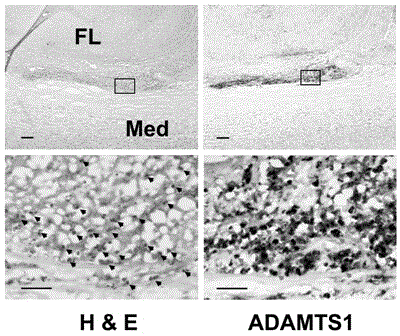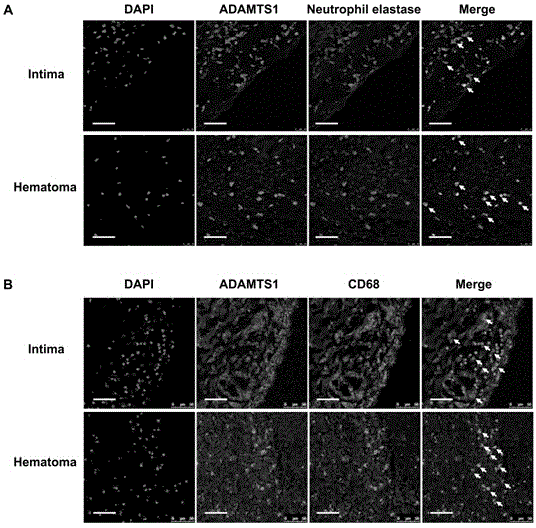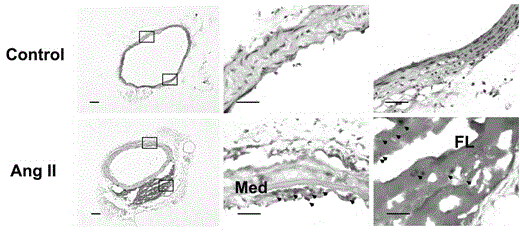Application of ADAMTS1 as aortic dissection clinical screening molecular marker
A molecular marker, arterial dissection technology, applied in the field of medicine and biology
- Summary
- Abstract
- Description
- Claims
- Application Information
AI Technical Summary
Problems solved by technology
Method used
Image
Examples
Embodiment 1
[0016] Enzyme-linked immunosorbent assay (ELISA) was used to detect plasma ADAMTS1 levels in patients with acute aortic dissection (AAD) (16 cases), patients with acute myocardial infarction (AMI) (26 cases) and normal people (19 cases).
[0017] Collection criteria for patients with aortic dissection: Symptoms: sudden severe chest and back tear-like pain, accompanied by uncontrollable hypertension; auxiliary examination: Aortic CT or MRI shows that the aorta has a false cavity.
[0018] The specific conditions of each group of cases are shown in the table below:
[0019]
[0020] The ELISA test showed that the plasma ADAMTS1 level is 0.87±0.12 ng / ml in normal people, the plasma ADAMTS1 level in patients with myocardial infarction is 0.98±0.14 ng / ml, and the plasma ADAMTS1 level in patients with aortic dissection is 1.44±0.25 ng / ml,
[0021] The plasma ADAMTS1 level of patients with aortic dissection was significantly higher than the first two groups. Statistical analysis by Onewa
Embodiment 2
[0024] Example 2 Research on Mouse Model of Aortic Dissection
[0025] A mouse aortic dissection model was successfully established with angiotensin II (Ang II) implanted pump administration method. Male C57 mice aged 8-9 months were implanted with a slow-release pump subcutaneously in the back. The administration group was pumped with angiotensin II 2500 ng / kg / min, and the control group was pumped with normal saline. The samples were taken 14 days after the pump was buried. Artery, extract total RNA for real-time quantitative PCR, extract total protein for Western Blot, fix and embed the slice for HE staining, elastic plate staining, immunohistochemistry and immunofluorescence.
[0026] The results are as follows:
[0027] The blood pressure (SBP) of mice in the AngII-administered group was significantly higher than that in the control group. The incidence of dissection in the AngII-administered group was 42%, and the incidence of dissection in the control group was 0.
[0028]
Embodiment 3
[0031] Take the plasma samples of 150 patients with acute chest pain, and test the plasma samples according to the detection method in Example 1. The content of ADAMTS1 is> 1.2ng / ml is used as the criterion, and if it is higher than 1.2ng / ml, it is determined that the patient has an aortic dissection. The test results showed that the ADAMTS1 content of 69 samples was> 1.2ng / ml, CT examination of the aorta showed that the 69 samples were all AD patients.
[0032] Other tests proved that among the other 81 samples, 8 were aortic aneurysms, 6 were aortic intramural hematomas, 41 were acute coronary syndromes, 4 were pulmonary embolism, and 22 were chest pains caused by other causes. CT proved that there were no patients with aortic dissection in the 81 samples, indicating that the diagnostic accuracy of ADAMTS1 was 100%.
[0033] In addition, according to the non-patent literature Wu Wenjing et al., a comparative study of plasma ADAMTS-9 levels in patients with aortic dissection an
PUM
 Login to view more
Login to view more Abstract
Description
Claims
Application Information
 Login to view more
Login to view more - R&D Engineer
- R&D Manager
- IP Professional
- Industry Leading Data Capabilities
- Powerful AI technology
- Patent DNA Extraction
Browse by: Latest US Patents, China's latest patents, Technical Efficacy Thesaurus, Application Domain, Technology Topic.
© 2024 PatSnap. All rights reserved.Legal|Privacy policy|Modern Slavery Act Transparency Statement|Sitemap



